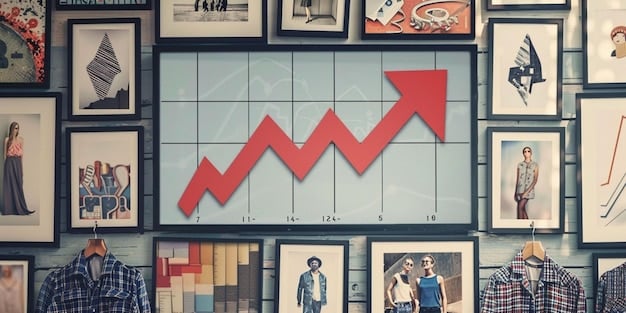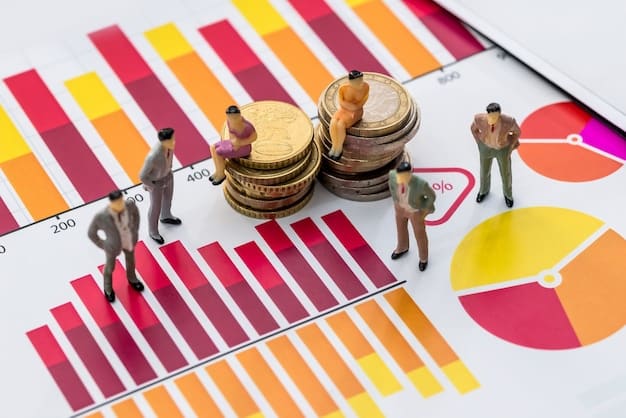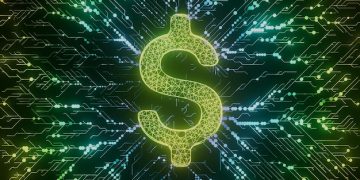Consumer Confidence & Economic Growth in the US: A Deep Dive

Understanding the relationship between consumer confidence and economic growth in the US involves analyzing how optimistic or pessimistic consumers are about their financial situation and the overall economy, which directly influences their spending and saving behaviors, thereby impacting economic activity.
The U.S. economy’s performance is closely tied to the sentiment of its consumers. Understanding the relationship between consumer confidence and economic growth in the US is crucial for investors, policymakers, and everyday citizens alike. How we feel about our financial prospects shapes our spending habits, which in turn, drive economic activity.
What is Consumer Confidence?
Consumer confidence is an economic indicator that measures the degree of optimism that consumers feel about the overall state of the economy and their personal financial situation. It is a key factor in determining consumer spending, which accounts for a significant portion of the U.S. gross domestic product (GDP).
A high level of consumer confidence suggests that consumers are optimistic about the future and are more likely to make purchases, boosting economic growth. Conversely, low consumer confidence indicates pessimism and a reluctance to spend, which can lead to economic stagnation or recession.
Key Factors Influencing Consumer Confidence
Several factors can influence consumer confidence, including:
- Employment: Job security and the unemployment rate play a significant role.
- Income: Wage growth and disposable income levels are crucial determinants.
- Inflation: Rising prices can erode purchasing power and dampen confidence.
Measuring Consumer Confidence
Consumer confidence is typically measured through surveys. The two most widely followed surveys in the U.S. are:
- The Conference Board Consumer Confidence Index (CCI)
- The University of Michigan Consumer Sentiment Index (MCSI)
Both surveys ask consumers about their current financial situation, expectations for the future, and spending plans. The results are then compiled into an index, providing a snapshot of consumer sentiment.

In conclusion, consumer confidence serves as a vital barometer of economic health. It reflects the collective sentiment of consumers and their willingness to spend, invest, and save, ultimately influencing the trajectory of economic growth.
The Relationship Between Consumer Confidence and Economic Growth
The relationship between consumer confidence and economic growth in the US is a cyclical one. High consumer confidence typically leads to increased spending, which in turn boosts economic growth. Conversely, low consumer confidence can lead to decreased spending and economic contraction.
When consumers are confident, they are more likely to make big-ticket purchases such as cars, homes, and appliances. This increased demand stimulates production, creating jobs and further boosting economic activity. However, when consumers are fearful about the future, they tend to cut back on spending and save more, which can lead to a slowdown in economic growth.
How Consumer Spending Drives GDP
Consumer spending accounts for approximately 70% of the U.S. GDP, making it the largest and most important component of economic activity. When consumers spend more, businesses generate more revenue, which allows them to hire more workers and invest in expansion. This creates a positive feedback loop that fuels economic growth.
Conversely, when consumer spending declines, businesses may be forced to cut back on production, lay off workers, and postpone investments. This can lead to a negative feedback loop that exacerbates economic contraction.
The Role of Government Policy
Government policies can also influence consumer confidence and economic growth. Fiscal policies, such as tax cuts or stimulus spending, can boost consumer spending and stimulate economic activity. Monetary policies, such as interest rate cuts, can encourage borrowing and investment, which can also boost economic growth.
However, government policies can also have unintended consequences. For example, excessive government debt can erode consumer confidence and lead to higher interest rates, which can dampen economic growth.
In conclusion, the relationship between consumer confidence and economic growth is complex and multifaceted. It is influenced by a variety of factors, including consumer sentiment, government policies, and global economic conditions. Therefore, understanding this relationship is essential for policymakers, investors, and anyone interested in the health of the U.S. economy.
Historical Trends and Patterns
Over the past few decades, the U.S. economy has experienced periods of both high and low consumer confidence, each with corresponding effects on economic growth.
During the late 1990s, the U.S. experienced a period of strong economic growth, fueled by the dot-com boom and rising consumer confidence. As consumers became more optimistic about the future, they increased their spending, leading to higher corporate profits and increased investment.
The Impact of Recessions
The 2008 financial crisis triggered a sharp decline in consumer confidence, as millions of Americans lost their jobs and homes. Consumer spending plummeted, leading to a deep recession. The government responded with a massive stimulus package, which helped to stabilize the economy and restore some consumer confidence.
- 2008 Financial Crisis: Consumer confidence plummeted, leading to a deep recession.
- Post-Recession Recovery: Gradual improvement in consumer confidence and economic growth.
- COVID-19 Pandemic: Initial shock led to a sharp decline, followed by a recovery.
Long-Term Trends
Despite these short-term fluctuations, there are also some long-term trends to consider. For example, consumer confidence has generally been trending upward since the end of the 2008 financial crisis, reflecting a gradual improvement in the U.S. economy.
However, there are also some challenges that could weigh on consumer confidence in the future. These include rising income inequality, increasing healthcare costs, and growing concerns about climate change.

In conclusion, understanding historical trends and patterns in consumer confidence can provide valuable insights into the future of the U.S. economy. By analyzing past performance, we can better anticipate how consumer sentiment will impact economic growth in the years to come.
The Role of Global Economic Factors
Global economic factors can also play a significant role in influencing consumer confidence and economic growth in the U.S. These factors include:
Trade wars, currency fluctuations, and global recessions can all have a significant impact on consumer sentiment and economic activity in the U.S. For example, a trade war between the U.S. and China could lead to higher prices for imported goods, which could erode consumer purchasing power and dampen confidence.
Impact of International Events
Similarly, a global recession could lead to lower demand for U.S. exports, which could hurt U.S. businesses and lead to job losses. This, in turn, could further depress consumer confidence and economic growth.
- Trade Policies: Tariffs and trade agreements affect prices and consumer choices.
- Geopolitical Events: Political instability can create uncertainty and fear.
- Global Pandemics: Disrupt supply chains and alter consumer behavior.
The Interconnected Global Economy
The interconnected nature of the global economy means that events in one country can quickly spread to others. This can create both opportunities and risks for the U.S. economy. For example, strong economic growth in China could boost demand for U.S. exports, leading to higher corporate profits and more jobs in the U.S.
However, a financial crisis in Europe could lead to a decline in global demand, which could hurt U.S. businesses and lead to job losses. Therefore, it is important to monitor global economic conditions closely and to be aware of the potential risks and opportunities they present.
In conclusion, global economic factors are an important consideration when assessing the relationship between consumer confidence and economic growth in the US. By understanding these factors, we can better anticipate how global events will impact the U.S. economy and make more informed decisions about investments, policies, and business strategies.
Strategies for Boosting Consumer Confidence
Given the importance of consumer confidence for economic growth, it is essential to explore strategies that can help boost consumer sentiment. These strategies may involve government policies, business practices, and individual actions.
Government policies can play a crucial role in boosting consumer confidence. For example, tax cuts can put more money in the hands of consumers, encouraging them to spend more. Similarly, investments in infrastructure can create jobs and stimulate economic activity.
Effective Policies and Initiatives
Other effective policies might include:
- Job Creation Programs: Reduce unemployment and increase job security.
- Financial Education: Empower consumers to make informed decisions.
- Social Safety Nets: Provide support during economic hardships.
Business Strategies
Businesses can also play a role in boosting consumer confidence. By offering high-quality products and services at competitive prices, businesses can build trust with consumers. Similarly, by treating employees well and investing in their communities, businesses can create a positive image that resonates with consumers.
Individual actions can also contribute to boosting consumer confidence. By managing their finances responsibly, avoiding excessive debt, and investing in their education, individuals can improve their financial security and feel more optimistic about the future.
In conclusion, boosting consumer confidence requires a multifaceted approach involving government policies, business practices, and individual actions. By working together, we can create a more stable and prosperous economy that benefits everyone.
Future Outlook and Predictions
Looking ahead, the future of consumer confidence and economic growth in the U.S. is uncertain. Several factors could influence the trajectory of the economy in the years to come.
One key factor is the pace of technological change. Rapid advances in artificial intelligence, automation, and other technologies could lead to significant job losses in some industries, which could depress consumer confidence. However, these technologies could also create new opportunities for innovation and economic growth.
Potential Economic Scenarios
Another important factor is the aging of the U.S. population. As more Americans retire, there will be fewer workers to support them, which could put pressure on government finances and lead to higher taxes. This could weigh on consumer confidence and economic growth.
- Technological Advances: Automation impacts on job security and productivity.
- Demographic Shifts: Aging population and its effects on social security.
- Global Economic Trends: The role of emerging markets and global stability.
Expert Opinions
Despite these challenges, there are also reasons to be optimistic about the future. The U.S. remains one of the most innovative and dynamic economies in the world, and it has a long history of overcoming challenges and adapting to change.
Furthermore, many economists believe that the U.S. is on the cusp of a new industrial revolution, driven by advances in renewable energy, biotechnology, and nanotechnology. These technologies could create new jobs and boost economic growth in the years to come.
In conclusion, while the future is uncertain, there are reasons to be both cautious and optimistic about the outlook for consumer confidence and economic growth in the U.S. By understanding the key factors that are likely to shape the economy in the years to come, we can make more informed decisions about our investments, policies, and business strategies.
| Key Point | Brief Description |
|---|---|
| 📊 Consumer Confidence | Measures how optimistic consumers are about the economy. |
| 💰 Spending & GDP | Consumer spending drives about 70% of the U.S. GDP. |
| 🌍 Global Economy | Global events and trade policies impact U.S. consumer confidence. |
| 📈 Future Outlook | Technology, demographics, and global trends shape future confidence. |
Frequently Asked Questions
▼
The CCI is a survey-based measure that reflects consumers’ feelings about current and future economic conditions. It’s a valuable tool for assessing the overall health of the economy.
▼
Low confidence generally leads to reduced spending. This can cause businesses to experience lower sales, potentially leading to layoffs and decreased investments in growth.
▼
Yes, certain government actions like tax cuts or job creation programs can improve job security and financial stability, thereby increasing consumer confidence levels.
▼
Global events, such as trade wars or pandemics, can introduce uncertainty and impact supply chains, potentially leading to decreased consumer confidence in the U.S.
▼
Yes, indicators like GDP growth, unemployment rate, and inflation provide a more complete view of the economy, helping you understand the context behind consumer sentiment.
Conclusion
In conclusion, understanding the relationship between consumer confidence and economic growth in the US is crucial for navigating the complexities of the economy. By monitoring consumer sentiment and its influencing factors, we can better anticipate economic trends and make informed decisions for the future.






